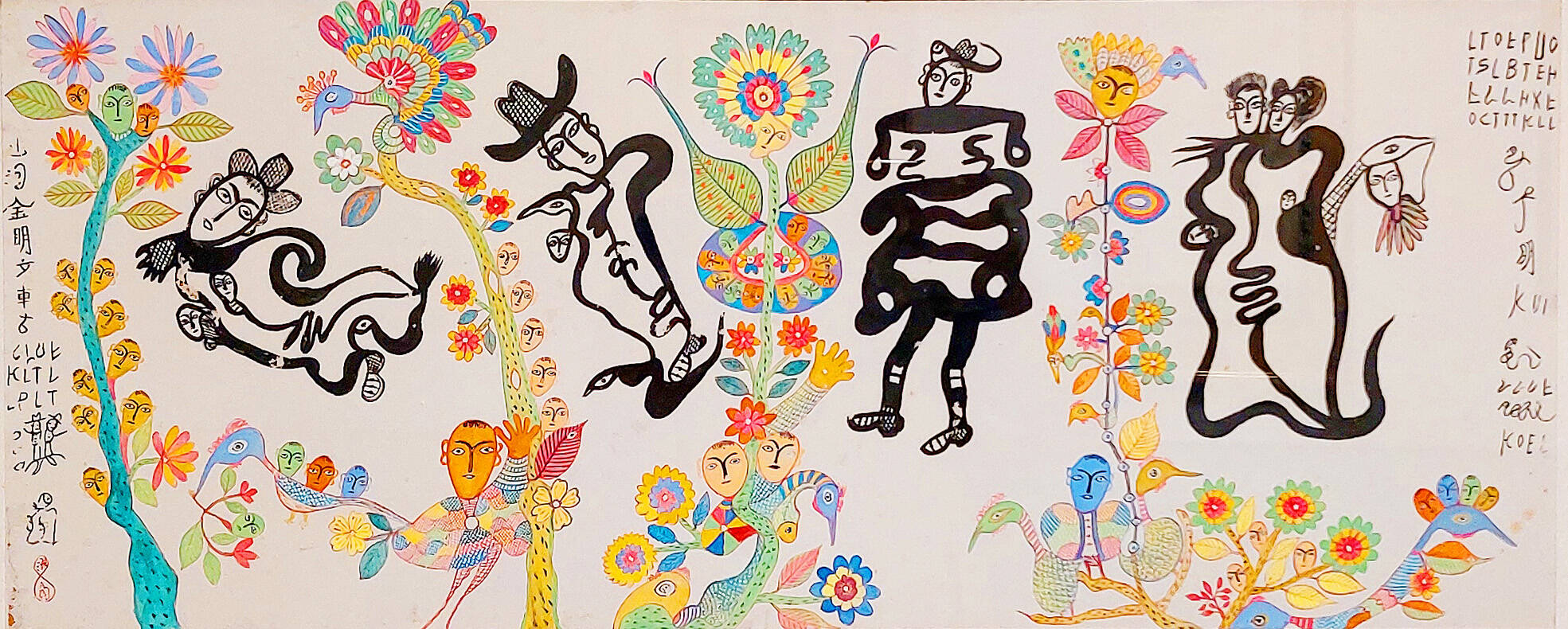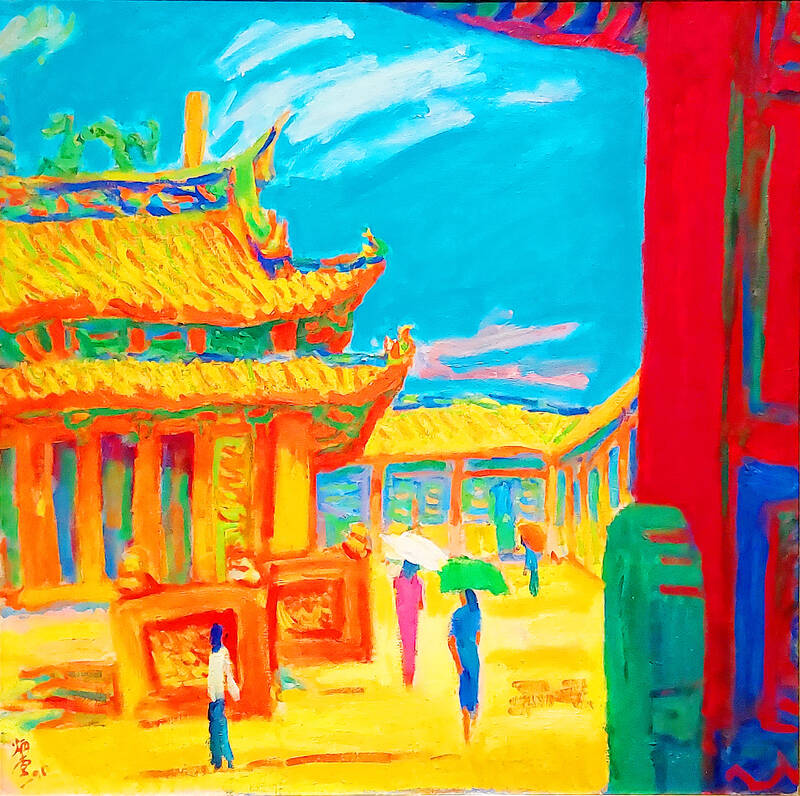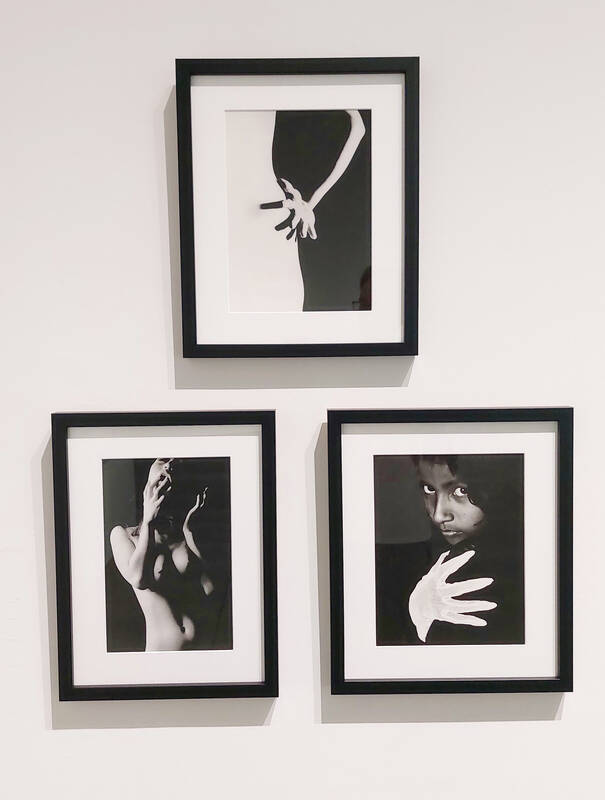Tainan Art Museum has put together an exhibition as part of its efforts to promote local artists. “Focus” features works by painters Hung Tung (洪通), Chang Ping-tang (張炳堂), Tsai Tsao-Ju (蔡草如) and photographer Hsu Yuan-fu (許淵富).
The collection of Chang’s works focus on the theme of temples, showcasing bold, vibrant colors and a style that eschews perspective in favor of a flat quality. In his painting Tainan Confucius Temple, a sunny courtyard under a blue sky is framed by a dark red passageway, placing the viewer inside one of the temple buildings looking outside. The warm, saturated colors are far from realistic, and reinforce the juxtaposition between spiritual and temporal spaces.
Visitors who complete viewing Chang’s colorful designs are met by Hsu’s stark, black-and-white creations adorning the gallery’s walls. Hsu, who started out as an amateur photographer, is known for his skill at manipulating light and shadows. To express the emotions of his subjects, Hsu focused on three main aspects of the body: the face, the hands and posture.

Photo: Doruk Sargin
The exhibition includes about 30 works by Hung, whose centennial was separately celebrated by the museum in 2020. This year’s feature on Hung is divided into three sections according to his different styles and sources of inspiration: “The Influence of Temples and Folk Art,” “Joyful Dreams of the Land,” and “Word-Paintings and Painted Words,” the latter of which showcases unique works featuring an invented language. Hung, who was illiterate, observed Chinese characters and the Latin alphabet to create symbols resembling them, and integrated them into his works.
Lastly, the exhibition showcases works by Tsai, who started out as a temple painter following the end of World War II and later stood out with his clear lines and carefully arranged compositions. He also employed anatomy, perspective and color theory in his works, and painted for more than 60 temples across Taiwan. His painting, Bo Le Judging a Horse, which won Tsai plaudits at the first post-war Taiwan Art Exhibition and encouraged him to further pursue fine arts, is on display at the “Focus” exhibition.

Photo: Doruk Sargin

Photo: Doruk Sargin

On April 26, The Lancet published a letter from two doctors at Taichung-based China Medical University Hospital (CMUH) warning that “Taiwan’s Health Care System is on the Brink of Collapse.” The authors said that “Years of policy inaction and mismanagement of resources have led to the National Health Insurance system operating under unsustainable conditions.” The pushback was immediate. Errors in the paper were quickly identified and publicized, to discredit the authors (the hospital apologized). CNA reported that CMUH said the letter described Taiwan in 2021 as having 62 nurses per 10,000 people, when the correct number was 78 nurses per 10,000

As we live longer, our risk of cognitive impairment is increasing. How can we delay the onset of symptoms? Do we have to give up every indulgence or can small changes make a difference? We asked neurologists for tips on how to keep our brains healthy for life. TAKE CARE OF YOUR HEALTH “All of the sensible things that apply to bodily health apply to brain health,” says Suzanne O’Sullivan, a consultant in neurology at the National Hospital for Neurology and Neurosurgery in London, and the author of The Age of Diagnosis. “When you’re 20, you can get away with absolute

May 5 to May 11 What started out as friction between Taiwanese students at Taichung First High School and a Japanese head cook escalated dramatically over the first two weeks of May 1927. It began on April 30 when the cook’s wife knew that lotus starch used in that night’s dinner had rat feces in it, but failed to inform staff until the meal was already prepared. The students believed that her silence was intentional, and filed a complaint. The school’s Japanese administrators sided with the cook’s family, dismissing the students as troublemakers and clamping down on their freedoms — with

As Donald Trump’s executive order in March led to the shuttering of Voice of America (VOA) — the global broadcaster whose roots date back to the fight against Nazi propaganda — he quickly attracted support from figures not used to aligning themselves with any US administration. Trump had ordered the US Agency for Global Media, the federal agency that funds VOA and other groups promoting independent journalism overseas, to be “eliminated to the maximum extent consistent with applicable law.” The decision suddenly halted programming in 49 languages to more than 425 million people. In Moscow, Margarita Simonyan, the hardline editor-in-chief of the